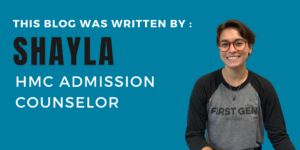Tip of the Month: So You’re Starting Your College Search…part 2
May 25, 2022
Welcome back and welcome to part 2 of starting your college search. In Part 1, we covered, well, YOU! After you have done your own reflection, it’s time to look outward.
Connect with Colleges
Don’t be afraid to join the mailing list for colleges you are considering. This is the best way to get up-to-date information from these institutions.
Joining the mailing list tells the college in question that it’s ok for them to send you their brochures. While the internet is great, a school’s website contains information for everyone (students, faculty, staff, alumni, etc.); the literature you receive from colleges has been created only with you in mind – it contains any and all information that could be relevant to you as a prospective student.
Colleges will also use their mailing list to inform you of any upcoming events on campus (such as their open house or fly-in programs) or in your area (like if an admission officer is visiting your high school or hosting an information session near you). Events such as these can be a great help when determining if a college is the right fit for you and joining the mailing list is the best way to stay in the loop!
Here’s one last motivator for you to join the mailing list: some colleges will track your level of interest, meaning they will keep a record of the ways you interact with them prior to submitting your application. While not all colleges do this, including Harvey Mudd, it can’t hurt to stay in touch!
Connect With Your Family
The cost of college can be restrictive to many families. You should discuss this openly with your parents.
All colleges are required to have a Net Price Calculator on their website. A Net Price Calculator uses your family’s financial position to make an estimate on the amount of need-based financial aid that may be available to you. Your family’s “net price” is the difference between this estimated aid and the total cost of attendance (basically, what your family would be expected to contribute).
If cost is a big issue for your family, then make sure to check your family’s net price for each of the institutions you might be considering.
And Then?
My suggestions above will help you start thinking about your college list. Here are a few other things you should keep in mind:
- Take people’s opinions with a grain of salt. This includes the guidebooks and rankings! You are the one that will be living and learning at the school of your choice, so why should you let what others think affect how you feel about it? You are looking for a place that will work for YOU!
- Remember you will be pursuing your undergraduate degree. The faculty and resources available to graduate students might not be accessible to undergrads. Make sure you research what opportunities will be available to you.
- Keep track of the different deadlines and application requirements to these schools. Soon you will have to begin planning and preparing for standardized tests, and before you know it, you will be asking teachers to write recommendations on your behalf – it is common for different colleges to ask for different things!
- Make sure your list shows a range of schools. It’s sad when students keep themselves from applying to institutions where they could be accepted just because they are worried that they won’t be. It’s also sad when students only apply to schools where they have a low chance of being admitted. Make sure you look both at colleges where you could be a definite admit and at colleges where it might be a reach.
- Try to visit the colleges you are considering. Visiting campus helps many students figure out whether or not they can actually see themselves spending the next few years of their lives at that particular institution. Can you see yourself walking through the halls and studying in the library? What about attending events on-campus or at the neighboring town or city?
My last piece of advice is for you to be open to change. The things you look for in a college at the beginning of your college search might not be the same as the ones you look for as your list becomes more concrete. This is ok! A big part of this process should be frequent self-reflection and re-evaluation, so refer to Part 1 when needed. 